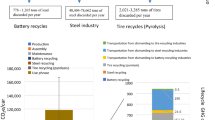Abstract
Background, Aims and Scope
When joining the European Union on 1st May 2004, Estonia had to conform its legislation to the European Union legislation. In relation with that, also the treatment requirements on end-of-life vehicles proceeding from Directive 2000/53/EC of the European Parliament and of the Council of 18 September 2000 were established in Estonia for the first time. Since this area was not regulated with law beforehand, there was not any information available about it. The aim of the current survey was to ascertain the condition of scrap yards in mid 2004. In addition to that, also to identify the number of scrap yards operating in Estonia, to classify these by the number of dismantled vehicles and the potential environmental hazard, and to map the locations of car dismantling companies and evaluate their compliance with the valid requirements.
Methods
The companies that have been registered in the Commercial Registry under the activity code 503090-end-of-life vehicle dismantling were visited and visually reviewed. During the visits, the compliance of scrap yards with the existing requirements was evaluated and it was also attempted to identify how environmentally sound the dismantling technology of every scrap yard owner is.
Results and Discussion
Altogether, 63 scrap yards operated in Estonia by mid 2004. Twelve of them dismantled more than 100 vehicles, 13 of them 51-99 vehicles and 38 up to 50 vehicles a year. The total annual market capacity on dismantling of vehicles in Estonia is considered to be approx. 10,000 units. There are very few companies dealing only with car dismantling as the main business. Most scrap-yard owners also offer side services, e.g. haulage, car repair and maintenance. The dismantlers are interested in the selling of second-hand spare parts and scrap metal. Only one company out of 63 complied with all the requirements enacted by the relevant decision of the Estonian Minister of Environment. The rest of the scrap yards did not meet the requirements on the site on storage and treatment nor did they have the hazardous waste handling licence or the waste permit. Of the requirements established for the site for storage of end-of-life vehicles, 97% of the scrap yards were surrounded with a fence, 67% had a 24-hour guard, 45% had covered the areas with waterproof cover, but only 3% had an oil trap. Sites for treatment were in a somewhat better condition, these were mostly situated inside the buildings, where floors were covered with waterproof covers. Most of the dismantlers collected the waste oil and waste fluids into separate vessels, but there were a number of dismantlers who did not know of existence of polychlorinated biphenyls (PCB) in car air conditioning systems and the availability of mercury in sensors belonging in passenger safety systems. Proceeding from the general condition of the scrap yard, the rest of 62 scarp yards were distributed between two empirical parameters - 'rather environmentally hazardous' or 'rather not environmentally hazardous'. As a matter of fact, 17% of scrap yards turned out 'rather environmentally hazardous'.
Conclusion
Out of the scrap yards operating in Estonia, only one is compliant with the requirements set up by Directive 2000/53/EC. Another 62 appeared during the review to be sites of potential environmental pollution. In order to comply with environmental requirements and get the hazardous waste treatment license, the scrap yard owners have to invest into state-of-the-art dismantling and environment protection equipment. The main obstacle to reach the environmentally sound scrap-yard is the high investment cost and the black market for spare parts.
Recommendation and Outlook
As the correction of the market in end-of-life vehicle treatment started after the adoption of Directive 2000/53/EC, the environmental authorities have to look after the ongoing correction. It is because there is still a demand for cheap spare parts and it makes it attractive to dismantle the vehicles out of scrap-yards by licensees.
Similar content being viewed by others
Author information
Authors and Affiliations
Corresponding authors
Rights and permissions
About this article
Cite this article
Aolaid, A., Teder, J. The Dismantling of End-of-Life Vehicles in Estonia Before Putting into Effect the Directive 2000/53/EC (3 pp). Env Sci Poll Res Int 13, 140–142 (2006). https://doi.org/10.1065/espr2005.08.281
Received:
Accepted:
Published:
Issue Date:
DOI: https://doi.org/10.1065/espr2005.08.281




